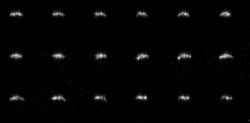Astronomy:2010 AL30
 | |
| Discovery | |
|---|---|
| Discovery date | January 10, 2010 |
| Designations | |
| none | |
| Minor planet category | Apollo NEO[1] |
| Orbital characteristics[1] | |
| Epoch 13 January 2016 (JD 2457400.5) | |
| Uncertainty parameter 2 | |
| |{{{apsis}}}|helion}} | 1.3688 astronomical unit|AU (204.77 Gm) |
| |{{{apsis}}}|helion}} | 0.72437 AU (108.364 Gm) |
| 1.0466 AU (156.57 Gm) | |
| Eccentricity | 0.30787 |
| Orbital period | 1.07 yr (391.07 d) |
| Average Orbital speed | 28.5 |
| Mean anomaly | 156.409° |
| Mean motion | 0° 55m 13.944s /day |
| Inclination | 3.8300° |
| Longitude of ascending node | 112.376° |
| 97.711° | |
| Earth MOID | 0.000981553 AU (146,838.2 km) |
| Jupiter MOID | 3.59473 AU (537.764 Gm) |
| Physical characteristics | |
| Dimensions | ~30 meters (elongated)[2] |
| Rotation period | 0.14660 h (0.006108 d) |
| ? | |
| Absolute magnitude (H) | 27.2 |
2010 AL30 is a near-Earth asteroid that was discovered on 10 January 2010 at Grove Creek Observatory, Australia.[1][3]
Italian scientists Ernesto Guido and Giovanni Sostero told RIA Novosti that it had an orbital period of almost exactly one year and might be a spent rocket booster.[4] However, it was determined that it is a near-Earth asteroid.[5]
On January 13, 2010 at 1246 UT it passed Earth at 0.0008624 astronomical unit|AU (129,010 km; 80,170 mi),[1] about 1/3 of the distance from the Earth to the Moon (or 0.33 LD).
Based an estimated diameter of 10–15 m (33–49 ft), if 2010 AL30 had entered the Earth's atmosphere, it would have created a meteor air burst equivalent to between 50 kT and 100 kT (kilotons of TNT). The Nagasaki "Fat Man" atom bomb had a yield between 13–18 kT.[6]
It has an uncertainty parameter of 2 and has been observed by radar.[1] Radar observations show the asteroid is elongated and is about 30 meters in diameter.[2] It may be a contact binary.
See also
References
- ↑ Jump up to: 1.0 1.1 1.2 1.3 1.4 "JPL Small-Body Database Browser". http://ssd.jpl.nasa.gov/sbdb.cgi?sstr=2010AL30;cad=1. Retrieved 31 March 2016.
- ↑ Jump up to: 2.0 2.1 "First Results of the Goldstone High-Resolution Chirp Radar Imaging System: Application to Near-Earth Asteroid 2010 AL30". NASA/JPL Asteroid Radar Research. 2011-10-04. http://echo.jpl.nasa.gov/asteroids/2010AL30/2010al30.html. Retrieved 2012-03-21.
- ↑ Malik, Tariq (12 January 2010). "Weird Object Zooming by Earth Wednesday is Likely an Asteroid" (in en). Space.com. https://www.space.com/7772-weird-object-zooming-earth-wednesday-asteroid.html.
- ↑ What was that Mystery object whizzes past Earth, The Times of India, January 14, 2010
- ↑ Small Asteroid 2010 AL30 Will Fly Past The Earth. NASA/JPL Near-Earth Object Program, January 12, 2010.
- ↑ Near-Earth Object 2010 AL30. NASA Earth Science Picture of the Day March 06, 2010.
External links
- MPEC 2010-A59 : 2010 AL30 – (Minor Planet Center / 2010 Jan. 11)
- MPEC 2010-A64 : 2010 AL30 – (Minor Planet Center / 2010 Jan. 12)
- Mystery object 2010 AL30 to pass within 130,000 km of Earth (heraldsun.com)
- NEO 2010 AL30 Close Approach – (Remanzacco Observatory / January 11, 2010)
- Goldstone detects "STRONG" radar echoes from 2010 AL30 – (Emily Lakdawalla / Jan. 12, 2010)
- First Results of the Goldstone High-Resolution Chirp Radar Imaging System: Application to Near-Earth Asteroid 2010 AL30 – (2011 October 4)
- Weird Object Zooming by Earth Wednesday is Likely an Asteroid, www.space.com, January 2010
- 2010 AL30 at NeoDyS-2, Near Earth Objects—Dynamic Site
- Ephemeris · Obs prediction · Orbital info · MOID · Proper elements · Obs info · Close · Physical info · NEOCC
- 2010 AL30 at ESA–space situational awareness
- 2010 AL30 at the JPL Small-Body Database
 |

